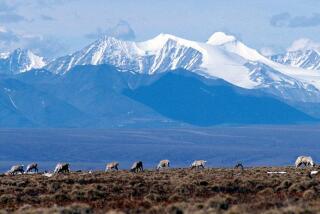Rush to Judgment on Arctic Oil Drilling : With little debate, a strapped Congress may endanger refuge
- Share via
A dispute as bitter as the Alaskan winter rages across the North Slope. Inupiat Eskimos on the coast, who stand to reap a bonanza in jobs, are eager to open the coastal plain of the Arctic National Wildlife Refuge to oil and gas exploration and drilling. But 150 miles to the south, Gwich’in Indians, too far away to get the jobs, see only calamity, fearing drilling would ruin the calving grounds of the migrating caribou herd on which they subsist.
The Inupiat-Gwich’in conflict is just one layer of the complex national debate over opening the remote refuge to oil companies. The majority of Alaskans have long favored drilling but always ran into a wall of environmentalists and their allies in Congress. Now for the first time the pro-drilling forces have a good shot at success.
BUDGET BAILOUT: That is not because of an urgent need for Alaskan oil but because Congress, desperate to pass a budget without still more painful cuts, sees 1.4 billion dollar signs. The budget resolutions of both houses, subject to change, assume a $1.4-billion Alaskan gusher, over five years, from oil leasing and rentals along the 100-mile-long, federally owned coastal plain. So presto, with little debate the budget reconciliation could open the refuge. President Clinton, opposed to drilling, would face intense political pressure against a veto of legislation needed to fund government operations.
At issue are 1.2 million acres of tundra along the Beaufort Sea. The frigid area teems with fragile flora and caribou, musk oxen, polar bears, wolves and peregrine falcons.
Oil proponents cite the national security need to reduce dependence on foreign supplies. They say modern drilling techniques have low environmental impact and avoid the spider web of development that has marred the nearby Prudhoe Bay fields. Opponents, led by Interior Secretary Bruce Babbitt, maintain that the risk of damaging a unique environment is too great. Babbitt likens it to damming the Grand Canyon to produce hydroelectric power.
Momentum for drilling has increased with the new clout of Alaska’s three-man congressional delegation, all Republicans and no great friends of the environment--Sens. Ted Stevens and Frank H. Murkowski and Rep. Don Young. Murkowski now heads the powerful Senate Energy and Resources Committee.
The economics of drilling in the refuge are questionable. When President Ronald Reagan pushed to open the refuge in 1987, oil was expected to sell for $33 a barrel, in 1984 dollars, by the year 2000. The current world oil surplus has pushed such projections much lower, and a recent report by the U.S. Geological Survey concluded that potential reserves, once thought to be 4 billion or 5 billion barrels, are “significantly smaller.” Even 5 billion barrels equal just one year’s consumption by American refineries--not much of a long-range solution to foreign dependence.
GOODY FOR ALASKANS: Alaskan voters see the refuge as a way to continue their free ride. Thanks to oil production, Alaska has no income tax and every Alaskan gets an annual “dividend” of about $1,000. All that will be threatened when the oil at Prudhoe is played out.
Neither Alaskans’ attachment to their yearly checks nor concern about the federal deficit is a sufficient reason to open the arctic refuge. Drilling proponents have some cogent arguments, and ultimately Congress may want to permit at least some exploratory drilling. But the issue is too crucial and complex to deal with in Washington’s frenzy of budget reconciliation over the next three weeks.
Environmentalists are urging Clinton to declare the refuge a national monument if Congress does not back off. This would put the area under National Park Service control and bar drilling. Clinton may indeed have to resort to that to slow this train down.
More to Read
Sign up for Essential California
The most important California stories and recommendations in your inbox every morning.
You may occasionally receive promotional content from the Los Angeles Times.










